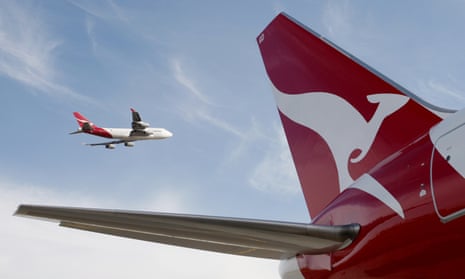Qantas is banking on resuming some overseas flights by December, as it posted a pre-tax annual loss of $1.83bn.
Qantas chief executive Alan Joyce blamed “diabolical” border conditions for the result, noting the financial position reflected a full year of closed international borders and more than 330 days of domestic travel restrictions.
Joyce says Covid has cost the airline $16bn in revenue so far, and he believes that figure will grow to $20bn by the end of 2021.
Thousands of Qantas staff across domestic and international operations remain stood down, and the Transport Workers Union, responding to Thursday’s financial announcement, has renewed calls for the government to take an equity stake in Qantas because of what the union claims is $2bn in public funding the airline has received throughout the pandemic.
However despite posting the loss and Australia’s most populous states being under indefinite lockdowns, the airline on Thursday was touting its plan to restart international travel within coming months.
Qantas is fixing its plans to restart flights in line with the 80% of population fully vaccinated target set out in the national cabinet’s plan C of reopening.
Highly vaccinated countries are top of Qantas’ list, with the company assuming flights between Australia and New Zealand will resume from mid-December.
Singapore, the United States, Japan, the United Kingdom, Canada and Fiji have also been earmarked as destinations the airline plans to fly to from mid-December, however it notes travel uptake will “hinge largely on government decisions on alternative requirements to mandatory hotel isolation for fully vaccinated travellers”.
Qantas’ plans to fly to destinations with lower vaccination rates, including Bali, Jakarta, Manila, Bangkok, Phuket, Ho Chi Minh City and Johannesburg, have been pushed out from December to April next year.
A federal government ban on Australians leaving the country without an exemption that was introduced in March 2020 remains in place.
Qantas also appears to be growing increasingly frustrated with state governments’ hard domestic border closures.
While before the pandemic the airline had set up direct flights between Perth and London and looked to make the city a stopover for travellers from east coast cities, the airline is now investigating using Darwin as a transit point, after months of flying directly from Europe to the Northern Territory capital for government-organised repatriation flights.
Qantas said Darwin could be used “as an alternative [or in addition] to its existing Perth hub given conservative border policies in Western Australia”. The company said discussions on this option are continuing.
Qantas’ revenue for the 2020-21 financial year dropped by 58.4% to $5.93bn, however it managed to reduce net debt from $6.05bn at December last year to $5.9bn by the end of June.
Qantas will not pay its shareholders any dividend for the financial year.
“Things remain tough, especially for thousands of our people waiting to return to their jobs when borders open and hopefully stay open,” Joyce said.
“Our focus is getting them back to work as soon as possible, which is why we were ramping up our flying and adding new destinations before the most recent lockdowns.
“When Australia reaches those critical vaccination targets later this year and the likelihood of future lockdowns and border closures reduces, we expect to see a surge in domestic travel demand and a gradual return of international travel,” he said.
Quick GuideHow to get the latest news from Guardian Australia
Show

Email: sign up for our daily morning and afternoon email newsletters
App: download our free app and never miss the biggest stories
Social: follow us on YouTube, TikTok, Instagram, Facebook or Twitter
Podcast: listen to our daily episodes on Apple Podcasts, Spotify or search "Full Story" in your favourite app
On resuming international travel, Joyce – who has previously had to revise his airline’s international resumption – said he “can’t rule out having to move them again”.
“Talking to airline CEOs overseas, it’s clear the rest of the world is opening up – especially across the UK, Europe and United States. Australia now also has a plan for re-opening.”
Joyce acknowledged “the prospect of flying overseas might feel a long way off” and that “some people might say we’re still being too optimistic”.
“But the current pace of the vaccine rollout means all Australian states are on track to reach the 80% target by December – which is the trigger for starting to carefully open to some parts of the world.”
Earlier this week, the airline released a new ad that promotes getting a Covid-19 vaccine, appealing to Australians longing to travel again.
Last week, Qantas announced it will require all of its employees to be fully vaccinated against Covid-19, as debate about mandatory vaccination in Australian workplaces intensifies. It had previously foreshadowed it would require passengers on international flights to be vaccinated.
At the beginning of August Qantas stood down a further 2,500 domestic staff, on top of the 6,000 international staff in the same position.
